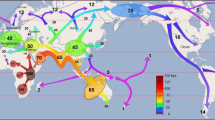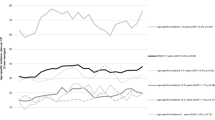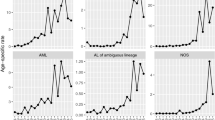Abstract
The incidence of childhood leukaemia in The Netherlands in the period 1973-1986 was studied by means of the DCLSG nationwide register, which lists all patients according to bone marrow slides classified in the DCLSG central laboratory. Acute lymphocytic leukaemia (ALL) accounted for 81% of cases, acute non-lymphocytic leukaemia (ANLL) for 13%, chronic myelocytic leukaemia (CML) for 2.5%, and acute unclassifiable leukaemia (AUL) for 3%. The peak incidence of ALL was at age 3, common-ALL and pre B-ALL comprising about 95% of the immunophenotypes at this age. Incidence rates for ALL remained stable between 1973 and 1978 at 2.85 cases per 10(5) children per year, exhibited a temporary increase between 1979 and 1984 to 3.60 and dropped back to the lower, previous level in 1985 and 1986. This rise was seen mainly among children in the 1-4 year age group, especially at age 3, and those with common-ALL and an initial WBC less than 5.0 x 10(9) l-1. Cumulative incidence rates per year of birth were fairly homogeneous up to age 6, except for the 1978 birth cohort which exhibited higher rates. Incidence rates for ANLL, CML and AUL remained stable over time. Changes in ascertainment, declining birth rates and a 50% decrease in childhood mortality, e.g. from infectious diseases, could not explain this temporary variation. Moreover, incidence rates in this survey appeared to be similar to those reported in various developed countries for the same period. As far as the aetiology of childhood common-ALL is concerned, therefore, the Dutch data appear to support the hypothesis of 'random mutation' as well as that of a limited role of environmental factors.
This is a preview of subscription content, access via your institution
Access options
Subscribe to this journal
Receive 24 print issues and online access
$259.00 per year
only $10.79 per issue
Buy this article
- Purchase on Springer Link
- Instant access to full article PDF
Prices may be subject to local taxes which are calculated during checkout
Similar content being viewed by others
Author information
Authors and Affiliations
Rights and permissions
About this article
Cite this article
Coebergh, J., van der Does-van den Berg, A., van Wering, E. et al. Childhood leukaemia in The Netherlands, 1973–1986: Temporary variation of the incidence of acute lymphocytic leukaemia in young children. Br J Cancer 59, 100–105 (1989). https://doi.org/10.1038/bjc.1989.20
Issue Date:
DOI: https://doi.org/10.1038/bjc.1989.20
This article is cited by
-
Incidence and survival time trends for Spanish children and adolescents with leukaemia from 1983 to 2007
Clinical and Translational Oncology (2017)



